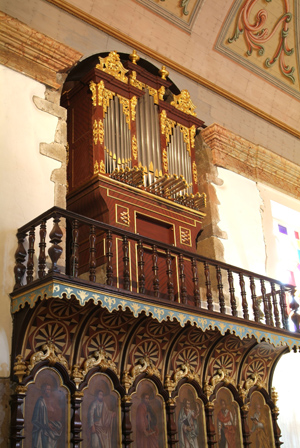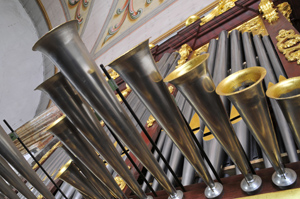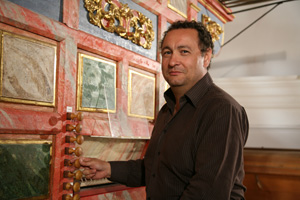 Sunday, 28 October, 6.00, p.m.
Sunday, 28 October, 6.00, p.m.
Church of Nossa Senhora da Conceição (Machico)
Javier Artigas, organ
The concert begins with five dances taken from the collection Intavolatura di balli d’arpicordo (1621) by Giovanni Picchi, organist in Venice at the Cà Grande and the Scuola di San Rocco. Characteristic of these dances is the melodic line in the upper voice (which reappears, far more ornamented, on subsequent repetitions) and a chordal accompaniment emphasizing the different dance rhythms.
Andrès Lorente, a Franciscan friar, is much better known as a musical theorist. His best known work is the treatise El porqué de la Música, printed in Alcalá de Henares in 1672, which was one of the standard books of its time on the science of music and composition, and which enables us today to try to understand the musical language of the 17th century. No other book containing his works survives, though in his treatise Lorente promised a Libro de Zifra de Organo que con el el favor de Dios sacarèmos a la luz en todo este Año de 1672, which was, unfortunately, never printed. The tiento which we shall hear in this concert is a work attributed to him in the Astorga manuscript.
The next section of this concert is a sequence of dances which gives us a vision of the 17th century in Spain. These works were compiled in a collection entitled Huerto ameno de varias flores de música between 1706 and 1709 by the Franciscan friar Antonio Martín y Coll. This illustrious cleric lived between the 17th and 18th centuries, and was a disciple of Lorente.
The central figure in composition for the organ in Spain at the end of the 17th century was, without a doubt, Joan Cabanilles, the 300th anniversary of whose death, on 29 April 1712, is commemorated this year. It is impossible to summarize the value and importance of Cabanilles in a few lines, but it is enough to say that he was titular organist of the instruments of the Cathedral of Valencia from 1666 until 1712. The work which we shall hear is the renowned Tiento de 5º Tono sobre Pange Lingua, one of the great successes of Iberian organ music. This is a series of variations on the hymn Pange lingua, in the more hispano version, in which the hymn melody moves from voice to voice, undergoing new harmonizations and more and more florid counterpoint and melodic ornamentation, producing at the end a musical climax with a final repetition of the theme. It is a masterly work in which all the compositional skills that had evolved over 200 years in the Iberian Peninsula are found, a compendium of organ composition of the renaissance and early baroque.
The concert ends with a group of four works by composers who, chronologically, belong to the turn of the 18th to the 19th century. It was the end of the more traditional period in organ writing and the beginning of a new era based above all on music from beyond the Pyrenees, with clear influences from the musical language of composers such as Haydn and Mozart, whose works survive in numerous transcriptions in cathedral archives, demonstrating that, to the contrary of what has generally been asserted, the reception of their works was extremely rapid. At this moment in history, though there attempts to advance in harmonic and melodic language, both forms and instruments obviously clearly limited their evolution, giving rise to music that, though modern in sound, was still anchored in the past. Composers of the period are Ramón Ferreñac, organist of the Basilica del Pilar in Saragossa (a contemporary of Goya and son of Manuel Ferreñac), by whom we will hear a Tempo de Minuè, which is nothing other than a series of variations on a minuet theme, written entirely in classical style, Frei Francisco Eguiguren, a Basque composer about whom nothing is known, but by whom we shall hear a work entitled Concerto Arioso (a sonata in one movement, in Italian style), Joaquín Laseca, organist of the Cathedral of Saragossa at the end of the 18th century, by whom we shall hear a Sonata in the 5th tone, bipartite in form, but classical in character, and Carles Baguer,organist of the Cathedral of Barcelona and one of the few composers from this period by whom orchestra music survives. Baguer wrote some nineteen symphonies in classical style, influenced by the great figure of Haydn, dominant at that time. Some of the symphonies were transcribed for organ by Baguer himself. One of these, in four movements, closes this recital.
Javier Artigas Pina
Organ Recital
Giovanni Picchi (1621)
Intavolatura di Balli d’Arpicordo
Padoana ditta la Ongara
Ballo Ongar.
Ballo detto il Picchi
Todescha
Ballo alla Polacca
Andrés Lorente (1624-1703)
Medio registro de dos tiples de Primer Tono
Huerto Ameno de varias flores de musica (Manuscript of Martín y Coll, 1709)
Danzas y Tonadas.
Vacas
Alamanda
Un ayre alegre
Zarabanda
Danza del Acha
Canarios
El Villano
Juan Cabanilles (1644-1712)
Tiento de 5º tono de Pange Lingua
Ramón Ferreñac (1763-1823)
Tempo de minué
Francisco Eguiguren (1743-?)
Concierto Arioso
Joaquín Laseca (1758-1820)
Sonata de 5º tono
Carles Baguer (1768-1808)
Symphony in F major
Allegro assai
Adagio con variaciones
Minuetto
Rondo Presto
Participants
|
Studied organ and harpsichord with José Luís González Uriol, winning the Extraordinary Prize for Finalists. Later he continued his studies with Radulescu, Torrent, Schnorr, Alain, Rogg, Houbard and others. As a soloist, he has performed regularly in festivals in Spain and other European countries, in Asia and America, and, as a chamber musician, he has worked with Ministriles de Marsias, Il Trio Galante, Ensemble 415 and La Oropéndola. His recordings include Tañer con Arte, awarded five stars by the magazine Goldberg, and, as musicologist, he was responsible for the new transcription and edition of the keyboard works of Jusepe Jiménez and of Frei Juan Bermudo. He is currently director of the Department of Early Music and professor of organ and harpsichord at the Higher Conservatory of Múrcia, as well as invited professor at the Early Music Department of ESMUC (Barcelona) and technical director of the Early Music Festival of Daroca and the International Organ Days of Saragossa. He is also in charge of the preservation and restoration of the organs of the Region of Múrcia, amongst which is the great Merklin-Schütze organ (1954). |
Notes about the Organ
 Church Nossa Senhora da Conceição, Machico
Church Nossa Senhora da Conceição, Machico
In the historical documentation from before the 20th century there are references to two instruments: according to historical tradition, one was given to the Church of Nossa Senhora da Conceição in 1499 by King Manuel, and another acquired in 1746. As regards the Manueline organ, we may deduce that it was placed within the archway above the choirstalls on the Gospel side of the sanctuary. In the 18th century, the state of this instrument must have left much to be desired, leading to the acquisition of the second instrument in 1746. The organ arrived in Madeira in 1752, with the Council of the Treasury initially contributing the cost of purchase and later the installation costs.
The recent restoration undertaken by Dinarte Machado was done with the principal objective of returning as far as possible it to its original constitution, in accordance with indications to be gleened from the pieces of the instrument during its dismantling. Thus, the restoration always proceeded from a philosophy of taking into account the specificities of the original pieces, from the configuration of the case and its polychrome decoration, to the way the registration, pipiework, bellows-work and even its placement – in the sanctuary – were returned to how they were originally. As regards the composition of the stops, the split keyboard, with the reed stop in the right hand, which the organ indicated was an original feature, which indeed characterised the instrument. The original keyboard, which was found piled in a heap, and which it was possible to repair and reassemble retains the short octave, as was usual at this period. The new pipework was completed with great rigour in accordance with the characteristics of the few original pipes that had survived, compared with the actual indications and dimensions of the windchest, which was also studied and recorded in great detail.
There can be no doubt that this is one of the loveliest organs on the island of Madeira. It is one of the instruments that conserves some of the most typical features of Portuguese organ building in the 17th century. It should be stressed that the restoration work carried out on this instrument required study of considerable documentation, as well as comparison with other instruments of the period. Since no other instruments of this kind are to be found in Portugal, recourse was had to instruments from other countries for the necessary data.
Manual (C, D, E, F, G, A-c’’’)
Flautado de 12 palmos (8’)
Flautado de 6 palmos (4’)
Flauta doce
Dozena (2 2/3’)
Voz humana (c#’-c’’’)
Quinzena (2’)
Composta de 19ª e 22ª
Sesquialtera II (c#’-c’’’)
Clarim* (c#’-c’’’)
* horizontal reeds
 Javier Artigas Pina
Javier Artigas Pina